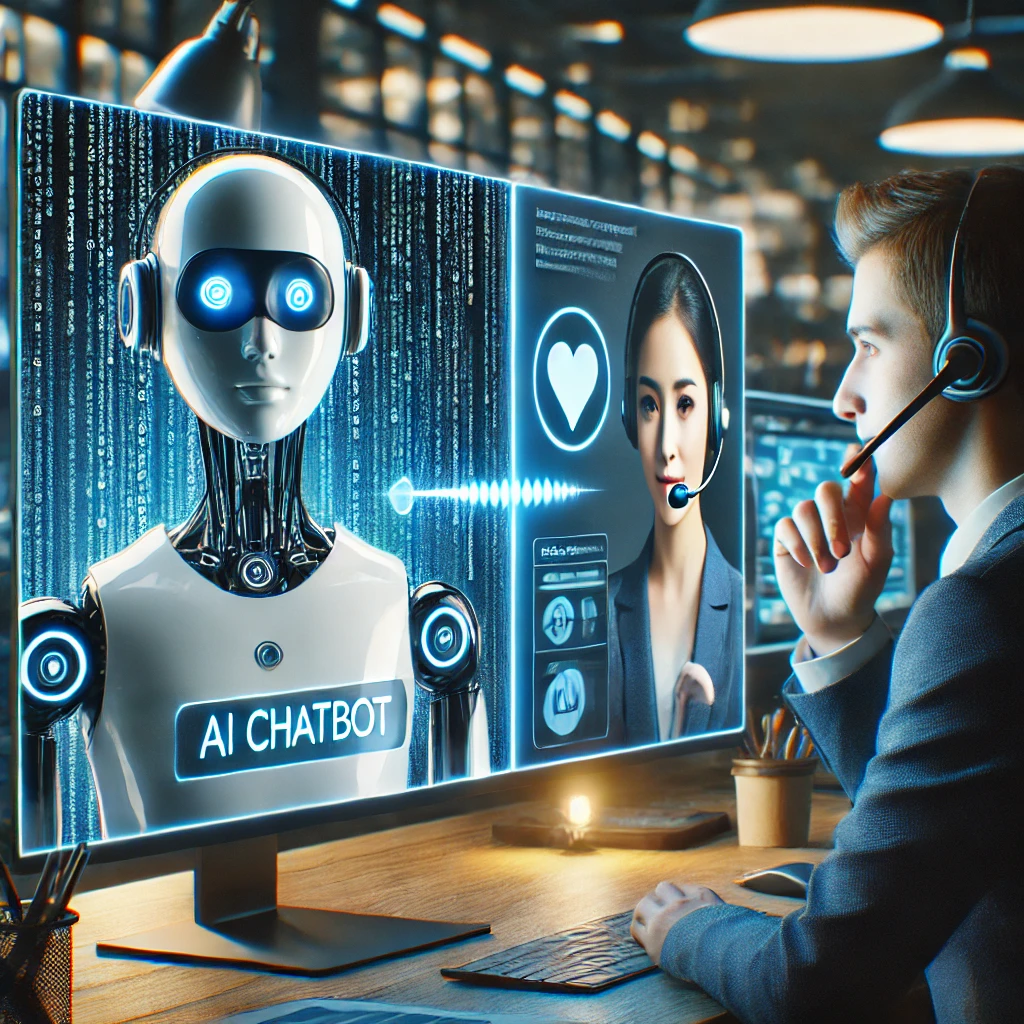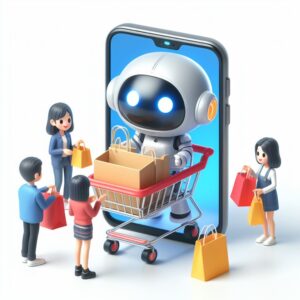AI Chatbots vs. Human Support—Who Wins?
AI chatbots have revolutionized customer service interactions across industries, transforming how businesses respond to inquiries and solve problems in the digital landscape.
When I think about customer service decades ago, it conjured images of friendly faces, pleasant voices, and that timeless philosophy that “the customer is always right.”
Those personal touches created memorable experiences that built loyalty and trust between consumers and brands.
Fast forward to today, and the landscape has dramatically shifted toward automation and digital interfaces that prioritize efficiency over connection.
More often than not, customer service now involves navigating through automated chatbots that direct you to FAQ pages in endless loops.
These interactions frequently leave customers feeling frustrated and unheard as they struggle to find solutions to their specific problems.
According to comprehensive research conducted by PwC on global customer experience, a staggering 59% of consumers believe companies have become shortsighted about automation.
This overreliance on technology has caused many businesses to lose touch with the essential human element that forms the foundation of exceptional customer experiences.
We strongly recommend that you check out our guide on how to take advantage of AI in today’s passive income economy.
Table of Contents
The Evolution of Customer Service Technology
From Personal Interaction to Automation
Customer service technology has undergone tremendous transformation in recent years, moving from primarily phone-based support to sophisticated digital systems.
The introduction of primitive chatbots marked the beginning of this evolution, offering simple predetermined responses to basic customer inquiries.
These early systems functioned through keyword recognition and could only handle straightforward questions with limited variation in phrasing.
As artificial intelligence and machine learning technologies advanced, chatbots became increasingly sophisticated in their ability to understand natural language.
Modern AI-powered systems can recognize context, remember previous interactions, and even detect emotional cues in text-based conversations.
Some advanced platforms incorporate sentiment analysis to gauge customer frustration levels and escalate issues to human agents when necessary.
Despite these technological improvements, many chatbot systems still struggle with complex queries that require nuanced understanding or creative problem-solving.
The limitations become apparent when customers present unique situations that fall outside the parameters of the chatbot’s programming and training data.
The Current State of Chatbot Technology
Today’s chatbot technology has certainly made impressive strides compared to earlier iterations that frustrated users with their limited capabilities.
Many contemporary systems can guide users through multi-step processes and access vast knowledge bases to retrieve relevant information quickly.
Some advanced platforms integrate with company databases to provide personalized responses based on customer history and account information.
These improvements have made chatbots valuable for handling routine inquiries like checking account balances, tracking orders, or providing basic product information.
However, even with these advancements, the technology still falls short when confronted with complex problems requiring critical thinking and emotional intelligence.
As David Liu, CEO of online payments provider Truvo, explains, “The technology definitely has come a long way, but now at the end of the day, what we find is that for customer service, a lot of the times people do want to talk to a human because problems are always more complex than simple questions.”
This fundamental limitation creates a significant gap between what automated systems can deliver and what customers ultimately need when facing challenging situations.
The disconnect has led many companies to reconsider their approach to customer service automation and the appropriate balance between technology and human support.
Understanding Customer Preferences
The Human Connection Factor
When examining customer service preferences across different demographics, interesting patterns emerge regarding the perceived value of human interaction.
Research consistently shows that while younger generations may be more comfortable with digital-first approaches, all age groups express a preference for human support in certain situations.
The desire for human connection becomes particularly pronounced when dealing with complex or emotionally charged issues that require empathy and understanding.
In these moments, customers seek reassurance and validation that their concerns are being taken seriously by someone who genuinely cares about their experience.
The emotional component of customer service cannot be understated, as it often determines whether a customer feels valued or merely processed through a system.
Human agents can pick up on subtle cues in a customer’s tone or choice of words that indicate underlying frustrations not explicitly stated in their inquiry.
This emotional intelligence allows human representatives to adapt their approach accordingly, offering reassurance or additional assistance that automated systems simply cannot provide.
The ability to build rapport through shared experiences or small talk may seem insignificant but often creates memorable service interactions that strengthen brand loyalty.
Industry-Specific Preferences
Customer preferences for human versus automated support vary significantly across different industries, with certain sectors showing stronger demand for person-to-person interaction.
Financial services consistently rank among the top industries where customers strongly prefer speaking with human representatives rather than navigating automated systems.
The complexity and personal nature of financial matters make human support particularly valuable when customers need to discuss sensitive information or receive guidance on important decisions.
Healthcare represents another field where human interaction remains highly valued, especially when patients seek information about symptoms, treatments, or insurance coverage.
The emotional component of health-related concerns makes empathetic human support essential for providing reassurance and clarity during stressful situations.
Legal services, luxury retail, and complex technical support are additional areas where customers demonstrate strong preferences for human assistance over chatbot interactions.
Liu notes this trend specifically in financial services: “When it comes to money, it’s very personal and very important to most people to be able to speak to a human. That’s really critical because you are anxious about the money and you want to get answers—that’s why humans are really the winner right now.”
This observation highlights how emotional factors significantly influence customer service preferences, particularly when the stakes feel high to the consumer.
The Cost-Benefit Analysis
The Business Perspective
From a business standpoint, the appeal of chatbot technology primarily centers around cost efficiency and scalability in customer service operations.
Automated systems can handle hundreds or thousands of simultaneous interactions without the limitations of human staffing constraints or associated labor costs.
The financial implications are substantial—a well-implemented chatbot can reduce customer service costs by 30% or more compared to traditional call center operations.
These savings come from decreased staffing requirements, reduced training costs, and the ability to provide 24/7 service without overtime or shift differentials.
Additionally, chatbots offer consistent service quality that doesn’t fluctuate based on agent mood, fatigue, or varying levels of training and experience.
The scalability factor becomes particularly valuable for growing businesses that need to support expanding customer bases without proportional increases in support staff.
Liu acknowledges this reality: “Cost has a significant impact, and also being able to service a lot of people at the same time as we scale and get substantially more customers. We will have to try to find ways to automate a lot of things.”
However, forward-thinking companies recognize that cost savings must be balanced against customer satisfaction and loyalty metrics that directly impact long-term profitability.
The Hidden Costs of Automation
While the immediate financial benefits of chatbot implementation are easily quantifiable, the potential hidden costs of excessive automation often receive less attention in business planning.
Customer frustration with inadequate automated support can lead to increased call escalations that ultimately require more intensive human intervention than if human support had been offered initially.
The emotional impact of negative service experiences can damage brand perception and erode customer loyalty, creating long-term revenue losses that far outweigh short-term operational savings.
Research from Accenture suggests that 52% of customers who experience poor service switch to competitor brands, taking their lifetime value with them and often sharing negative experiences with others.
This ripple effect of dissatisfaction can significantly impact new customer acquisition through damaged reputation and negative word-of-mouth in both personal networks and online reviews.
The productivity costs to customers themselves—time wasted navigating ineffective automated systems—creates additional friction that diminishes overall satisfaction with the brand relationship.
When customers finally reach human agents after struggling with automated systems, the interactions often begin with heightened frustration that makes resolution more challenging and time-consuming.
These factors create a compelling case for strategic implementation of automation that preserves human support for situations where it delivers superior value to both customers and the business.
The Limitations of Current Systems
Human Call Centers: Not Perfect Either
Traditional human call centers, while offering the personal touch many customers desire, come with their own set of significant limitations and frustrations.
Long wait times represent one of the most common complaints, with customers often spending precious minutes or even hours on hold before speaking with a representative.
The financial burden of toll calls or international charges can add insult to injury when customers must pay for the privilege of waiting for assistance.
Language barriers frequently create communication challenges when call centers operate from regions with different primary languages or strong accents that impede clear understanding.
Inconsistent training and high turnover rates in call center environments can result in vastly different service experiences depending on which agent handles a particular call.
Limited operating hours create accessibility issues for customers in different time zones or those who need assistance outside standard business hours.
Repetitive identity verification and case explanation becomes necessary when calls get transferred between departments or when customers need to call back multiple times.
Liu acknowledges these realities: “I don’t think there is really like a 100% perfect solution, whether it’s machine or human. One has to pick which areas are best served by human or machine or AI.”
This balanced perspective recognizes that neither approach offers a flawless solution for all customer service scenarios or individual preferences.
Chatbot Limitations
Despite technological advances, today’s chatbots continue to demonstrate significant limitations that frustrate users and diminish their effectiveness in complex service scenarios.
Natural language understanding remains imperfect, particularly when customers use colloquialisms, industry jargon, or phrases with nuanced meanings that confuse algorithmic interpretation.
Context maintenance across extended conversations poses challenges for many systems that struggle to reference previous statements when processing new information or requests.
Emotional intelligence represents perhaps the most significant limitation, as chatbots cannot genuinely empathize with customer frustration, anxiety, or other emotional states.
Creative problem-solving capabilities remain largely beyond current AI capabilities, limiting chatbots’ effectiveness when standard solutions don’t address unique customer circumstances.
The inability to read between the lines—understanding what customers imply but don’t explicitly state—creates missed opportunities to address underlying concerns or needs.
Most chatbots lack the authority to make exceptions to policies or offer goodwill gestures that human agents might provide to maintain customer relationships in challenging situations.
The rigid, programmatic nature of automated responses often feels mechanical and impersonal, reinforcing the perception that the company doesn’t truly value the individual customer.
These limitations explain why, as Liu notes, “Right as we speak now, it’s still not quite there, but we are getting there.”
This acknowledgment of current technological constraints helps set realistic expectations while recognizing the potential for future improvements.
Finding the Right Balance
Customer-Centric Approach
Developing truly effective customer service systems requires shifting focus from cost-efficiency alone to a more nuanced understanding of customer needs and preferences.
The most successful companies recognize that different customers have varying comfort levels with technology and preferences for how they receive assistance.
Liu highlights this diversity: “The reality is that different people have different preferences. Some people want to just look up FAQs and find the answers themselves, while others want to speak to someone human.”
This insight suggests that offering multiple support channels—self-service knowledge bases, chatbots, email, and human agents—creates the best overall customer experience.
Smart companies are implementing sophisticated routing systems that quickly identify which inquiries require human attention versus those that automated systems can handle effectively.
Giving customers control over their service experience—the ability to easily escalate from automated to human support when desired—significantly improves satisfaction rates.
Transparency about whether customers are interacting with automated systems or human agents helps set appropriate expectations and reduces frustration when limitations arise.
The goal should be creating seamless transitions between support channels rather than forcing customers to start over when moving from automated to human assistance.
The Hybrid Model
Many forward-thinking organizations are discovering that the most effective approach combines the strengths of both automated systems and human support in complementary ways.
In this hybrid model, chatbots handle routine inquiries, data collection, and preliminary troubleshooting to maximize efficiency and reduce wait times for all customers.
Human agents focus their expertise on complex problem-solving, emotionally sensitive situations, and high-value interactions that benefit most from personal attention.
AI systems can work alongside human agents, providing real-time information and suggestions that enhance the representative’s ability to deliver knowledgeable, efficient service.
This collaborative approach allows companies to scale their support capabilities while maintaining the quality of customer interactions where it matters most.
Some companies are implementing “AI-assisted human support” where chatbots handle initial interactions but seamlessly transfer to human agents who receive complete conversation history.
The most sophisticated systems use machine learning to continuously improve routing decisions, identifying patterns that indicate when automated or human support will be most effective.
This balanced approach recognizes that the question isn’t whether AI or humans provide better service, but rather how they can work together to create optimal customer experiences.
The Future of Customer Service
Technological Advancements on the Horizon
The customer service landscape continues to evolve rapidly with emerging technologies that promise to address current limitations in automated support systems.
Advanced natural language processing developments are enabling more sophisticated understanding of customer intent, even when expressed through colloquial or imprecise language.
Emotion recognition technology is improving chatbots’ ability to detect frustration, confusion, or satisfaction through text analysis and adapt responses accordingly.
Voice analysis capabilities are extending these emotional intelligence features to phone-based automated systems, creating more natural conversational experiences.
Machine learning algorithms are becoming increasingly adept at identifying patterns in successful service interactions and applying those insights to future customer engagements.
Predictive analytics allows systems to anticipate customer needs based on behavioral patterns and proactively offer relevant assistance before problems escalate.
Virtual reality and augmented reality technologies are opening new possibilities for visual demonstration and guidance in technical support scenarios.
These advancements suggest that the capabilities gap between human and automated support will continue to narrow, though the unique value of human connection will likely remain irreplaceable.
What Customers Ultimately Want
When we look beyond the technology debate, fundamental customer expectations remain remarkably consistent across generations and service channels.
Above all, customers seek efficient resolution—getting their problems solved correctly the first time without unnecessary repetition or transfer between departments.
They value personalized service that acknowledges their history with the company and doesn’t require explaining their situation multiple times to different representatives.
Accessibility across multiple channels gives customers the flexibility to seek support through their preferred method, whether that’s chat, phone, email, or social media.
Respectful treatment that makes customers feel valued rather than processed as transaction numbers significantly impacts overall satisfaction and loyalty.
Transparency about policies, limitations, and expectations helps manage frustration even when immediate solutions aren’t possible.
Follow-through on commitments—doing what was promised when it was promised—builds trust that extends beyond individual service interactions to the broader brand relationship.
As Liu succinctly states, “At the end of the day, it’s all about the customer service. If you can provide the right answers as quickly as possible, then that’s a winner. It doesn’t really matter how you provide the service as long as the person who needs the answer is getting it at the right time.”
This insight captures the essence of effective customer service, regardless of whether it’s delivered through advanced AI or compassionate human interaction.
Conclusion
The debate between AI chatbots and human customer support represents more than a technological comparison—it reflects fundamental questions about what constitutes meaningful service experiences.
While automated systems offer undeniable advantages in cost efficiency, scalability, and consistency for routine interactions, they continue to fall short in scenarios requiring emotional intelligence and complex problem-solving.
Human support provides irreplaceable value through empathy, creative thinking, and the ability to build authentic connections that strengthen customer loyalty and trust.
The most successful companies recognize that this isn’t an either/or proposition but rather an opportunity to strategically deploy both approaches where they deliver maximum value.
As technology continues to evolve, the distinction between automated and human support may become increasingly blurred through more sophisticated AI and integration of multiple service channels.
However, the fundamental goal remains constant: providing customers with efficient, respectful resolution to their issues through whatever means best accomplishes that objective.
Organizations that maintain focus on customer needs rather than cost considerations alone will discover the optimal balance between technological efficiency and human connection.
This customer-centric approach ultimately determines who wins in the AI versus human support comparison—not technology providers or cost-conscious executives, but the customers themselves.

We strongly recommend that you check out our guide on how to take advantage of AI in today’s passive income economy.




